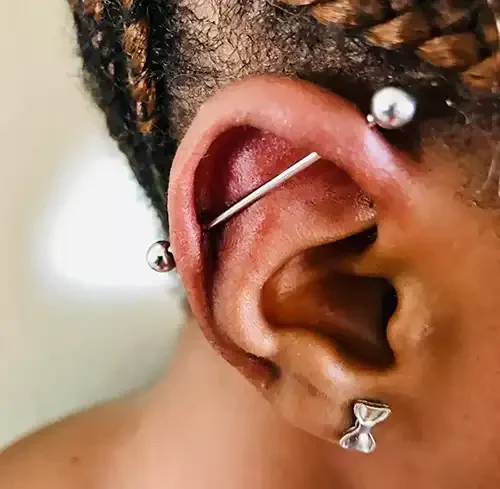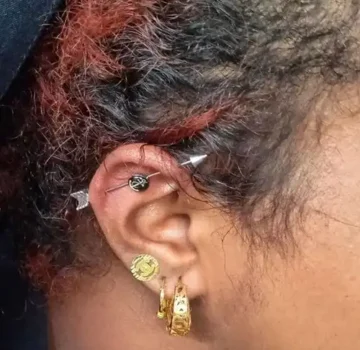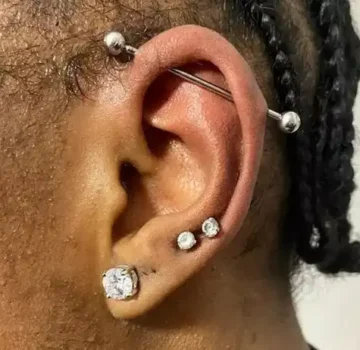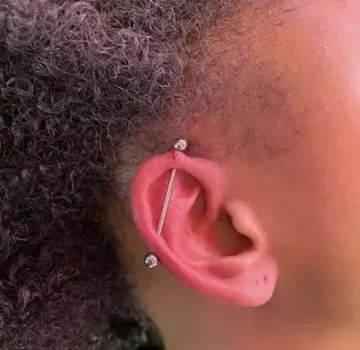Industrial Piercing in Nairobi, Kenya
An Industrial Piercing is a type of ear piercing that consists of two separate holes connected by a single piece of jewelry, usually a straight barbell. It is typically placed across the upper ear cartilage, with one hole on the outer edge (the helix) and the other near the inner part (the anti-helix). This piercing is also called a “scaffold piercing” in some regions.
Industrial Piercings
Key Features of Industrial Piercing
- Dual Piercings: It requires two distinct piercings that are aligned to hold a single barbell.
- Jewelry: Most industrial piercings use a straight barbell, but other designs, like curved or decorative barbells, can be used for a unique look.
- Versatile Style: Though the straight barbell is common, the look can be personalized with different materials, colors, and designs.
What are the different variations of Industrial Piercing
Industrial piercings are highly versatile, and variations allow for unique and personalized styles. Here are some popular variations of industrial piercings:
- Standard Industrial Piercing: The classic industrial piercing connects two points across the upper ear, typically the helix and anti-helix, using a straight barbell.
- Vertical Industrial Piercing: This variation runs vertically rather than horizontally, often connecting two points in the outer cartilage.
– Unique Touch: It adds an unconventional look and can be paired with curved barbells. - Double Industrial Piercing: Two industrial bars are placed on the same ear, either parallel or intersecting, for a dramatic effect.
- Spiral Industrial Piercing: Uses a spiral-shaped barbell to connect the two points, giving a swirling effect.
– Style Factor: Adds an artistic twist and is less common than straight barbells. - Floating Industrial Piercing: Two individual piercings are connected by two smaller barbells instead of one long bar.
– Benefits: Easier to heal and less prone to irritation compared to a single bar. - Custom Placements:
– Forward Industrial: Connects the forward helix to the inner ear cartilage.
– Cross Industrial: Features intersecting bars, creating an “X” shape.
– Personalization: Ideal for those with unique ear anatomy or creative style preferences.
Industrial Piercings Procedure
The Industrial Piercing procedure involves creating two separate piercings in the ear cartilage, which are connected by a single barbell. Here’s a step-by-step guide to what happens during the procedure:
- Consultation and Preparation
– Discussion: Our piercer explains the procedure, addresses any questions, and ensures the ear’s anatomy is suitable for an industrial piercing.
– Jewelry Selection: You’ll choose the initial barbell, often a plain titanium or surgical steel bar to reduce irritation during healing.
– Sanitization: Our piercer cleans the ear thoroughly with an antiseptic solution to minimize infection risk. - Marking the Piercing Points
– Alignment Check: Our piercer marks two points on the ear (usually on the helix and anti-helix) with a surgical pen, ensuring the barbell will sit straight.
– Client Approval: You’ll confirm that you’re happy with the placement before proceeding. - Piercing Process
– Sterile Needle: Using a hollow, single-use needle, our piercer creates the first hole on the helix and the second on the anti-helix.
– Barbell Insertion: Once both holes are made, the piercer threads the barbell through and secures it with small balls at either end. - Post-Piercing Care Instructions
– Our piercer provides detailed aftercare guidelines, including how to clean the piercing and what to avoid during healing.
– Cleaning Tools: Saline solution or specialized aftercare products are recommended for cleaning twice a day.
Considerations before getting an industrial piercing
Getting an industrial piercing is a commitment that requires careful consideration and preparation. Here are some important considerations before getting an industrial piercing:
- Pain Tolerance: Industrial piercings can be quite painful, as they involve piercing two cartilage areas in the ear. Make sure you have a reasonable tolerance for pain and are prepared for discomfort during the healing process.
- Professional Piercer: Research and choose a reputable, experienced, and professional piercer. Ask for recommendations from friends or read reviews online. Ensure the piercer follows strict hygiene and safety protocols.
- Jewelry Selection: Decide on the type of jewelry you want for your industrial piercing. Common options include barbells and hoops. Ensure the jewelry is of high-quality, hypoallergenic material like surgical steel, titanium, or niobium to minimize the risk of irritation or allergic reactions.
- Placement: Discuss the placement of your industrial piercing with your piercer. It’s essential to choose a location that suits your ear’s anatomy and style preferences. Ensure you and your piercer agree on the placement before the procedure.
- Healing Time: Be aware that industrial piercings can take a while to heal, often around 6 to 12 months. During this time, you need to follow proper aftercare instructions diligently to avoid complications.
- Aftercare: Understand the aftercare requirements for your industrial piercing. This usually involves cleaning the piercing with a saline solution, avoiding touching it with dirty hands, and not changing the jewelry until it’s fully healed.
- Lifestyle Considerations: Think about your lifestyle and how an industrial piercing may affect it. For example, some sports or activities may need to be modified or avoided during the healing process.
- Risk of Infection and Complications: Be aware of the potential risks, including infection, keloids, migration, and rejection. Consult with your piercer about how to minimize these risks.
- Cost: Consider the cost of the piercing itself, as well as the jewelry. High-quality jewelry can be expensive, but it’s essential for a safe and successful piercing.
- Commitment: Piercings are not easily reversed, so be sure you are committed to the idea of having an industrial piercing for the long term.
- Consultation: Schedule a consultation with your chosen piercer before the actual piercing appointment. This allows you to ask questions, discuss your preferences, and ensure you’re comfortable with the piercer’s approach.
- Medical Conditions: If you have underlying medical conditions or take medications, consult with your healthcare provider before getting a piercing to ensure it’s safe for you.
- Expectations: Have realistic expectations about the piercing process and outcome. Industrial piercings can look great when done right, but there may be some initial swelling and redness.
- Follow-Up Appointments: Be prepared for follow-up appointments with your piercer to check on the healing progress and make any necessary adjustments.
Industrail Piercings FAQ’s
Pain and Healing for an Industrial Piercing
Industrial piercings can be moderately painful and take longer to heal due to the cartilage involved and the fact that it requires two piercings. Here’s a detailed breakdown:
Pain Level
- Pain During Procedure:
– Typically rated as moderate, as cartilage is thicker and more rigid than earlobes.
– The first piercing might feel easier; the second may hurt slightly more as the area becomes sensitive.
– Pain is sharp but brief, lasting only a few seconds per piercing. - Pain After the Procedure:
– Expect soreness, throbbing, and mild discomfort in the first few days.
– Swelling and tenderness are common as the ear adjusts to the barbell.
Healing Process
- Healing Time:
– 6 to 12 months, though some may take up to a year for complete healing.
– Healing can vary depending on aftercare, your body’s healing ability, and how much stress is placed on the piercing.
Phases of Healing
- Initial Healing (0–3 months):
– The piercing may feel tender, and redness/swelling is normal.
– Avoid unnecessary touching, sleeping on it, or snagging it with clothing. - Intermediate Healing (3–6 months):
– Most of the swelling and redness will subside.
– Minor sensitivity may remain during cleaning or movement. - Final Healing (6–12 months):
– Fully healed tissue forms around the barbell.
– At this stage, jewelry changes can be made without issues.
Pain Management Tips
- Take over-the-counter pain relievers like ibuprofen if needed (consult a doctor if unsure).
- Apply a cold compress to reduce swelling in the first 48 hours.
- Practice good hygiene to avoid irritation and prolong discomfort.
Industrial Piercing Aftercare Guide
Proper aftercare is crucial for healing your industrial piercing and avoiding complications. Follow these steps for the best results:
- Cleaning Your Piercing
– Frequency: Clean the piercing twice a day, morning and evening.
– Products to Use:
→Saline Solution: A sterile saline or a sea salt soak is the best option.
→ Piercing Aftercare Spray: Pre-mixed solutions are convenient and effective.
→ Avoid harsh chemicals like alcohol, hydrogen peroxide, or antiseptics, as they can irritate the piercing.
– How to Clean:
→ Wash your hands thoroughly with soap and water.
→ Soak a clean cotton swab or gauze pad in the saline solution.
→ Gently dab around both holes and along the barbell to remove any crusted discharge.
→ Pat dry with a clean paper towel (avoid cloth towels to prevent bacterial transfer). - Avoid Irritation
– No Touching or Twisting: Refrain from twisting, rotating, or moving the jewelry unnecessarily.
– Sleep Smart:
→ Sleep on the opposite side to avoid pressure and irritation.
→ Use a travel pillow to keep pressure off the piercing if you must sleep on that side.
– Hair Care: Keep hair away from the piercing to avoid tangling or pulling. - Manage Swelling and Pain
– Apply a cold compress (wrapped in a clean cloth) for 10–15 minutes to reduce swelling.
– Avoid anti-inflammatory ointments unless recommended by a professional. - Lifestyle Adjustments
– Avoid Submersion: Keep the piercing away from pools, hot tubs, and lakes during the healing period.
– Be Careful with Accessories: Avoid headphones, hats, or anything that may press against the piercing. - Watch for Signs of Infection
– Normal Healing Symptoms: Mild redness, swelling, and clear discharge are normal for the first few weeks.
– Signs of Trouble:
→ Persistent swelling, yellow or green pus, fever, or excessive pain may indicate infection.
→ Seek advice from your piercer or a healthcare provider if you notice these symptoms. - Long-Term Care
– Healing time for an industrial piercing is 6–12 months.
– Avoid changing the jewelry until fully healed.
– Once healed, clean the piercing occasionally to maintain hygiene.
Industrial Piercing Jewelry
Jewelry for an industrial piercing typically consists of a single piece connecting two holes across the ear’s cartilage. While the standard option is a straight barbell, there are numerous styles to suit different preferences.
Standard Jewelry
- Straight Barbell
– The most common choice, designed specifically for industrial piercings.
– Features two threaded balls on either end for secure placement.
Materials for Jewelry
Choosing the right material is essential for comfort and healing.
- Titanium: Hypoallergenic and lightweight, making it ideal for sensitive skin and initial healing.
- Surgical Stainless Steel: Durable and affordable, but less suitable for people prone to metal allergies.
- Niobium: Biocompatible and flexible, great for those with allergies.
- Gold (14K or 18K): A luxurious option, but not recommended during the healing phase due to potential irritation.
- Acrylic or Silicone: Used for decorative purposes once fully healed but not advised for long-term wear.
Jewelry Variations
Industrial piercings are versatile, with several creative options:
- Decorative Barbells
– Gems and Crystals: Add sparkle and elegance with rhinestones or gemstones.
– Charmed Barbells: Feature hanging charms or pendants for a playful look.
– Themed Designs: Choose bars shaped like arrows, stars, or floral patterns for a unique touch. - Curved Barbells
– Often used for vertical or custom industrial piercings.
– Offers a softer aesthetic compared to the straight barbell. - Spiral Barbells: Twisted, corkscrew-like bars that add an artistic flair.
- Segment Rings or Captive Bead Rings (CBRs): Not traditional for industrial piercings but can be used creatively for individual holes.
Sizes to Consider
- Length: Most industrial barbells are 32mm–38mm (1.25–1.5 inches) in length.
– Length depends on the distance between your two piercing holes. - Gauge: The standard gauge (thickness) is 14G (1.6mm).
Tips for Choosing Jewelry
- Opt for high-quality, hypoallergenic materials for initial healing.
- Consider lightweight options to reduce strain on your ear during the healing phase.
- Always ensure the jewelry is sterilized and purchased from a reputable source.
Cost of a Industrial Piercing in Nairobi, Kenya
The cost of an industrial piercing can vary depending on factors such as location, the piercer’s experience, the studio’s reputation, and the type of jewelry you choose. Here’s a general breakdown:
Average Cost
- Basic Price:
– In most regions, industrial piercings cost Ksh. 2,000 – Ksh. 4,000
– This typically includes the piercing procedure and standard jewelry (e.g., titanium or surgical steel barbell). - Jewelry Upgrades
– If you choose premium materials like gold, niobium, or decorative barbells, expect an additional Ksh. 500 – Ksh. 2,000
– Custom or themed jewelry designs can be pricier.
Additional Costs
- Aftercare Products: Saline solution or piercing sprays may cost Ksh. 500 – Ksh. 1,000
- Follow-Up Visits: Some studios include follow-ups in the initial price, but others may charge Ksh. 500 – Ksh. 1,000
Industrial Piercing Cost Breakdown Table
Component / Package | Estimated Cost (KSh) | Details / Notes |
Piercing procedure + basic jewelry | 2,000 – 4,000 | As quoted by Rebel Inks Tattoos, Tattoo Removal, and Body Piercings |
Jewelry upgrade (gold/niobium/custom) | 500 – 2,000 | Adds aesthetic or hypoallergenic value |
Aftercare kit (saline spray, etc.) | 500 – 1,000 | May or may not be included in base price |
Follow-up / check-up | 500 – 1,000 | For resizing or healing inspection |
Estimated Total (Basic Package) | 2,000 – 5,000 | Piercing + standard jewelry + possible aftercare |
Estimated Total (All-Inclusive) | 3,000 – 8,000 | Piercing + standard jewelry + possible aftercare |
Factors Influencing the Cost
- Studio Reputation: Well-known studios with experienced piercers may charge more.
- Location: Urban areas or high-end neighborhoods often have higher prices. Rebel Inks Tattoos, Tattoo Removal, and Body Piercings Parlour is located in the heart of the Central Business Disrict (CBD) in Nairobi, Kenya, and is easily accessible to both locals and foreigners in the country.
- Piercer’s Experience: Highly skilled or certified piercers usually command a higher fee. At Rebel Inks Tattoos, Tattoo Removal, and Body Piercings Parlour we have experienced professionals who offer quality and premium services.
Possible Side Effects of an Industrial Piercing
Industrial piercings pass through cartilage, making them prone to certain side effects during and after the healing process. While proper care minimizes risks, here’s what to watch out for:
- Pain and Swelling
– What to Expect:
→ Moderate pain and swelling are normal for the first few days.
→ Discomfort can persist longer due to the double piercing and cartilage involvement.
– How to Manage:
→ Apply a cold compress to reduce swelling.
→ Take over-the-counter pain relievers (consult a doctor if unsure). - Infection
– Signs:
→ Persistent redness, warmth, swelling, and pain.
→ Yellow or green pus and an unpleasant odor.
– Causes:
→ Touching the piercing with unwashed hands.
→ Poor aftercare or exposure to unclean environments.
– What to Do:
→ Clean twice daily with saline solution.
→ Seek medical attention if symptoms worsen. - Cartilage Bumps (Hypertrophic Scarring)
– What It Is: Small, raised bumps often form near the piercing due to irritation or trauma.
– Causes:
→ Jewelry that’s too tight or too heavy.
→ Sleeping on the piercing or snagging it with hair or clothing.
– How to Treat:
→ Use a saline soak or chamomile tea compress to reduce irritation.
→ Avoid changing jewelry prematurely. - Keloids
– What It Is: Thick, raised scars that grow beyond the piercing area.
– Risk Factors: Some individuals are more prone to keloids based on genetics. - Jewelry Rejection or Migration
– Signs: The barbell shifts position or the skin around the piercing becomes thinner.
– Causes:
→ Using low-quality or inappropriate jewelry.
→ Excessive pressure or irritation during healing.
– What to Do:
→ Replace jewelry with hypoallergenic materials like titanium or niobium.
→ See a piercer for advice if migration is noticed. - Prolonged Healing or Delayed Closure
– Healing Time:
→ Industrial piercings typically take 6–12 months to heal.
→ Delayed healing can result from inadequate aftercare or excessive handling.
– What to Do: Follow a strict aftercare routine and avoid touching the jewelry unnecessarily. - Cartilage Cracking or Damage
– Rare, but Possible: Damage to the cartilage can occur if the piercing is not done correctly or due to trauma.
– Prevention: Choose an experienced, professional piercer. - Allergic Reactions
– Signs: Itching, redness, and irritation around the piercing.
– Causes: Sensitivity to metals like nickel in low-quality jewelry.
– Prevention: Use hypoallergenic jewelry made of titanium, niobium, or surgical steel.
When to Seek Help
- Severe pain, excessive swelling, or signs of systemic infection like fever.
- Persistent problems despite proper aftercare.
RELATED PIERCINGS
Get In Touch
For more information on the list above and any other special services,please call or come in for free consultation
Testimonials
I recommend them 💯
I would definitely recommend if you’re thinking of getting a piercing!
The staff were super friendly, explained everything clearly, and made me feel so at ease. They answered all my nervous questions (and I had many questions),
They walked me through the whole process, gave detailed aftercare instructions, and even followed up afterward to check how I was healing 🫶
Clean, professional, and full of good vibes.
Would 100% recommend . Definitely making a second trip here.
This was the second tattoo I got and I wish I could have come to Eric for my first one! He gave me really great after-care directions for the tattoo as well as a little jar of his own Vaseline-type stuff to put over my tattoo while it was healing! He even put second skin over my tattoo so that I didn’t have to worry about it for the first few days. Now THAT’S good service. My first tattoo artist didn’t do none of that lol.
After the session Eric didn’t rush me and my friend out, he chatted with us and even when he found out I was an artist too— really encouraged me to keep creating and to find a community of artists to support me. I almost cried because I’ve had such a hard time with my own art the past couple of years, it meant so much to me to have a fellow very talented artist say that to me. 🤍🤍🤍
Eric you’re amazing, don’t ever stop creating and just know you’ve impacted lives all over the world!🫶🏻 thanks so much for everything!!
From the moment I walked in, Eric was professional, welcoming, and attentive. He made sure I was comfortable throughout, provided everything I needed, and explained every step of the process. The tattooing itself was unbelievably smooth - I genuinely felt no pain compared to my previous tattoos over the last 22 years.
Eric also gave me excellent aftercare guidance and products, and thanks to that, my tattoo healed beautifully. The attention to detail, precision, and shading are absolutely stunning. This is hands-down the best tattoo I've ever had, and I will be flying back to Nairobi for any future ink.
If you want incredible art, a professional experience, and a talented artist who truly cares about his clients, Rebel Ink is the place to go!
From start to finish, the service was exceptional. The piercer was professional, knowledgeable, and made me feel completely comfortable. The cleanliness of the place was above and beyond — everything was spotless and hygienic, which really put me at ease. Highly recommend for anyone considering a piercing!
Shout out to Eric😘
We ended up changing the jewelry three times to ensure I had the best fit and avoided any signs of rejection, and he always listened to my suggestions as a client, which I really appreciated. Now, three months in, my piercing is healing beautifully, with no sign of rejection. Highly recommend for anyone who values a piercer who cares about your comfort and healing journey!
What stood out the most was the aftercare Eric checked in with me even three weeks later to see how the tattoo was healing. That kind of follow-up shows how much he truly cares about his work and his clients.
I’m very satisfied and will definitely be coming back for my next piece. Highly recommend!
The piercing wasn't as painful as I had thought and the process was quick and satisfactory. I love it!!!
The piercing is healing well thanks to the aftercare instructions and follow-up. I would highly recommend Rebel Inks
Eric also did a belly button piercing for a friend, guiding her through the process, doing the piercing and then explaining the after care to her.
The shop is on the 3rd floor, with the entrance to the stairs near an alleyway on the left. The shop is perfect size, clean, and attractive looking. The mural is pretty dope.
Thank you for the amazing service! 🔥👅✨
I got piercibgs there and the process was really good. My biggest concern was hygiene but that wasn't an issue at all, they use new needles and they sanitize them.
The service itself was also welcoming.
I was informes of everything i needed to know beforehand.
10/10 would recommend!
Eric was so calm and patient with my almost 2 year old lady. It was such a clean and hygienic process. We will definitely be back for our second rounds of piercings and maybe even another tattoo!
They assess the area before any art and advise one accordingly. They also give one post clean up process and also do a check up after the body art projects. Overall, I loved my experience and I’m hooked. 👍
Will definitely come back next time I’m in town 🙂
He listened to what I actually wanted and made sure he could fit in the time before I flew back home.
The shop is clean & private and is easy enough to find.
Eric has even checked in a couple of times since to make sure all is good.
I would totally recommend Eric! I absolutely love my Elephants!
I had a very easy healing period and always follow up from Eric to check on my progress...I would highly recommend if you are a first timer because from my experience all went very well and attention to detail
Thank you for a good job and looking forward to send all my friends your way
And all the best with the new year 2025!
From the moment I walked in, the staff was super friendly and made me feel at ease. The studio had a clean, professional atmosphere, which immediately put me at ease. My piercer was incredibly skilled and explained every step of the process, ensuring I was comfortable the entire time. The piercing was quick and practically painless, and the aftercare instructions were clear and easy to follow. I can tell they really care about the health and safety of their clients.
Overall, a fantastic experience—I highly recommend Rebel Inks and Tattoos for anyone looking to get pierced or tattooed!
They do follow up after their services
Eric's Studio isn’t just a place to get a tattoo—it’s an experience. The combination of professionalism, artistic talent, and a welcoming environment makes it a standout destination for anyone considering a tattoo.
I highly recommend Eric’s Studio to both first-timers and seasoned tattoo enthusiasts. If you’re looking for a high-quality tattoo and an enjoyable experience, this is the place to go.
I would definitely recommend their services again and again
Thank you Rebel Ink
My piercings are healing ❤️🩹 well
I would 💯 recommend
I will definitely come back for more .
Two, all the equipments he used for the piercings were new and/or sterilised.
Three, the parlour itself was very clean and was up to par with the hygiene standards.
Four, Eric provided effective aftercare instructions, making sure I knew exactly how to take care of my new piercings and he kept in touch and continues to do so, to check on the healing progress.
I highly highly highly recommend this place!!!
Would definitely recommend them to friends and go back for other piercings
Not only was the piercing process smooth, but he also provided thorough aftercare instructions, making sure I knew exactly how to take care of my new piercings. What really impressed me was that he keeps in touch to check on how the healing is progressing – a sign of true care for his clients.
The shop maintains a high standard of hygiene, and the atmosphere is welcoming and comfortable, which really added to the positive experience. I highly recommend this place to anyone looking for a professional and caring experience. I’ll definitely be coming back for any future piercings!
My appreciation for the excellent customer service I received. The follow-ups were prompt, and I truly appreciated the gentleness and professionalism throughout. Thank you!"
"Looking for professional eyebrow microshading removal? Look no further!"
The customer care is top tier 👌🏾👌🏾.
Wonderful place to get tattoos and piercings. 💯💯
Eric goes ahead to follow up on his clients progress and gives good advice each time I reach out to him.
I would recommend Reble tattoos anytime.
Good job bro we really appreciate.
Ohh and the price is very fair.
The environment was clean , procedure was sterile and the jewelry used are of the best quality.
He followed up with me during the healing process, he educated me on what I needed to do for my aftercare.
Eric is confident, skilled , experienced and the best piercer. Highly recommend Rebel inks.✨
Definitely recommend!
Great experience.
Eric definitely know what he is doing .
I got exactly what I wanted 2 tiny tats on the same finger .
He was kind and patient throughout the session.
Healing process has been good .
Aftercare services were given and regular checkups on the healing process were done.
I would 💯recommend.
Eric gave me the best reception as it was my first time there,and made me trust him all the way. I appreciate good services.
There services are also affordable not to forget 😊.
He was also invested in the aftercare and would ensure I follow the do's and don'ts in taking care of the tattoo and ensuring proper healing and maximum ink retention.
Would highly recommend Rebel Inks Tattoos.
Rebel Inks Tattoo offer the best,affordable and quality tattoo removal services.If you have unwanted ink,choose Rebel Inks Tattoo,they're the best of the best and the professionalism is a top notch.They ensure you're free from unwanted ink with their Laser Tattoo Removal Technology...
I did a Laser Tattoo Removal with them and i can attest they're the best....
Kudos Eric...
I highly recommend.
It was a generally good experience with good hygiene during the piercing process and has been a smooth healing process.... 10/10
tips. Highly recommend 👍🏽
100% recommendable.
I was particularly impressed with Eric's attention to hygiene. He thoroughly cleaned the room before I entered, sanitized all of the equipment he would be using, and changed gloves between each ear. This level of cleanliness gave me great confidence in his professionalism.
Eric's commitment to customer service did not end on the day of the piercing. He followed up with me regularly throughout the healing process to ensure that I was following the aftercare instructions and that my earlobes were healing properly.
I highly recommend Rebel Inks to anyone in Nairobi who is considering getting a piercing. Eric is a highly skilled and experienced piercer who takes great pride in his work.
So I Check all the boxes below and more:
Customer Care: ✔️
Professionalism : ✔️
Cleanliness ✔️
Price: ✔️
After care service ✔️
Thanks and good job, Eric
The place is neat and clean and the equipments he used were also fine standards. Really appreciate his following up with me on the healing 🤗
I WOULD HIGHLY RECOMMEND THEIR SERVICES to everyone. Actually what you see on their website is EXACTLY what you will get. Keep up the good work Rebel inks Tattoos.
The infection is now gone. I would definitely recommend!
Can recommend this place totally and would go back there anytime!
Thanks!
OUR LOCATION
Areas We Serve
NAIROBI
KIAMBU
KAJIADO
MACHAKOS






































































































































































































































